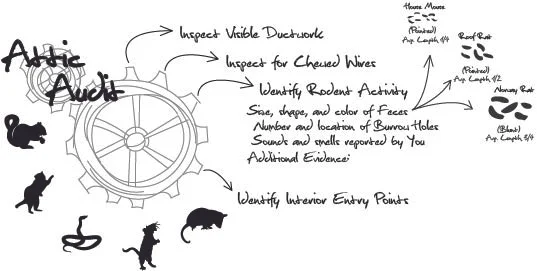Squirrel in Wall
Squirrels in the Wall
Introduction
Squirrels are cute, fluffy creatures that often captivate our attention with their playful antics in parks and backyards. However, they become a lot less adorable when they find their way into our homes, especially within the walls. A squirrel infestation can cause significant damage to your property and pose health risks to you and your family. This article will discuss the signs of squirrels in your walls, the damage they can cause, how they get inside, how to remove them, and how to prevent future infestations.
Signs of Squirrels in Your Walls
Scratching Noises
One of the most apparent signs of squirrels in your walls is the sound of scratching, scampering, or gnawing. These noises are typically more pronounced during the early morning and late afternoon when squirrels are most active.
Foul Odors
Another indication of squirrels in your walls is the presence of foul odors. These smells usually originate from squirrel droppings, urine, or even decaying carcasses. The odor can become particularly strong as time goes on and should not be ignored.
Droppings and Urine
Squirrel droppings and urine stains are clear signs of an infestation. These waste materials can accumulate in your walls, creating unsanitary conditions and even causing damage to your home's structure.
Damage Caused by Squirrels
Structural Damage
Squirrels can chew through wood, drywall, and other building materials, which can result in significant structural damage. They may also create entry points, allowing other pests to enter your home.
Insulation Damage
Squirrels often use insulation as nesting material, tearing it apart and leaving gaps that reduce its effectiveness. This can lead to higher energy bills and a less comfortable living environment.
Electrical Damage
Squirrels are known to chew through electrical wires, which can lead to short circuits, power outages, and even house fires.
How Squirrels Get Inside
Roof Vents and Soffits
Squirrels often enter homes through roof vents, soffits, or damaged fascia boards. They are skilled climbers and can easily access these areas to find shelter and warmth.
Gaps and Holes
Gaps or holes around
Continue writing please
pipes, windows, or doors can also provide entry points for squirrels. They can squeeze through surprisingly small openings, making it essential to thoroughly inspect and seal any potential entryways.
Removing Squirrels from Your Walls
Live Trapping
One of the most humane methods for removing squirrels is live trapping. You can purchase or rent traps designed specifically for squirrels and place them near the entry points they're using. Be sure to check the traps frequently and release the captured squirrels far from your property.
One-Way Doors
Another option for removing squirrels is installing one-way doors at their entry points. These devices allow the squirrels to exit your walls but prevent them from reentering. Once you're confident all squirrels have left, you can seal the entry points permanently.
Professional Help
If you're unsure how to remove squirrels from your walls or if the infestation is extensive, it's best to call a professional pest control company. They have the expertise and equipment to safely and effectively remove the squirrels and help you prevent future infestations.
Preventing Future Infestations
Seal Entry Points
Inspect your home thoroughly for any gaps or holes that could allow squirrels to enter. Seal these entry points with sturdy materials like metal flashing or hardware cloth to keep squirrels out.
Maintain Your Yard
Keeping your yard tidy and well-maintained can help deter squirrels from nesting near your home. Remove potential food sources like bird feeders, trim overhanging branches, and clean up any debris that could provide shelter.
Install Deterrents
There are various deterrents available to discourage squirrels from entering your property, such as motion-activated sprinklers or ultrasonic devices. Using these tools can help keep squirrels at bay and prevent future infestations.
Conclusion
Squirrels in your walls can cause significant damage and create unpleasant living conditions. It's essential to address the problem as soon as possible by identifying the signs of an infestation, removing the squirrels, and taking steps to prevent future issues. By being proactive and vigilant, you can protect your home from these unwelcome guests and maintain a safe, comfortable living environment.
FAQs
Q1: How can I tell if I have squirrels in my walls?
A: Some common signs include scratching noises, foul odors, and the presence of droppings or urine stains.
Q2: Can squirrels cause damage to my home?
A: Yes, squirrels can cause structural, insulation, and electrical damage, leading to costly repairs and potential safety hazards.
Q3: What's the best way to remove squirrels from my walls?
A: Options include live trapping, one-way doors, or hiring a professional pest control company.
Q4: How can I prevent squirrels from getting inside my home?
A: Seal entry points, maintain your yard, and install deterrents to discourage squirrels from entering your property.
Q5: Are there any humane methods for removing squirrels from my walls?
A: Live trapping and one-way doors are humane methods that allow for the safe removal of squirrels without causing harm.
All About Animals …
Suspendisse nec congue purus. Aenean eu justo sed elit dignissim aliquam. Suspendisse nec congue purus. Class aptent taciti sociosqu ad litora torquent per conubia nostra, per inceptos himenaeos.
RATS
SQUIRRELS
RACCOONS
OPOSSUMS
SNAKES
BATS
WILDLIFE REMOVAL
articles:
What does a rat nest look like ?
What is a Squirrel King










